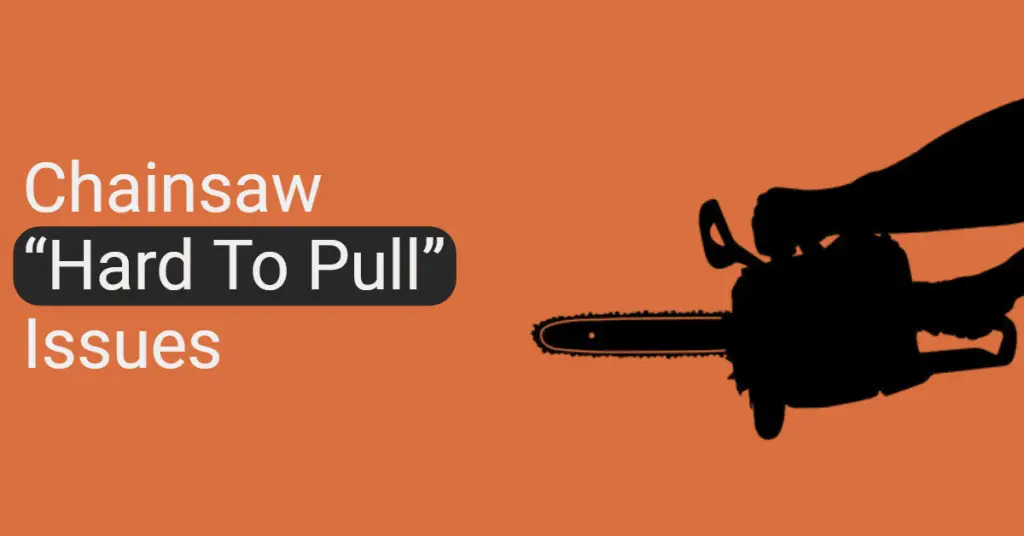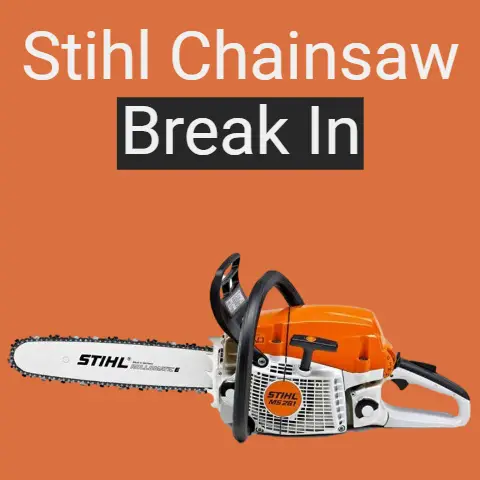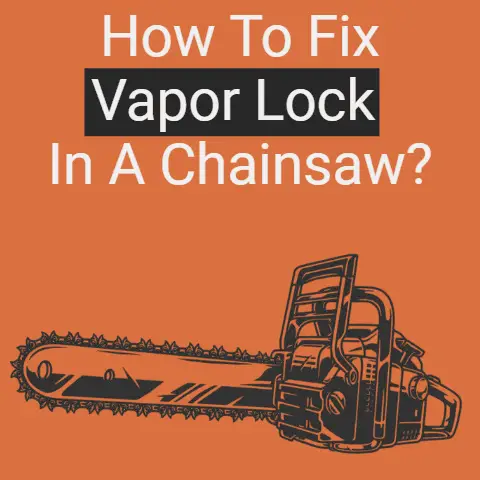Chainsaw “Hard To Pull” Issues: Check & Fix (Within 8 Min)
To find the possible problem, check the starter housing, pulley system, starter assembly, starter Spring, clylinder, bearing(s)/bushing, or starter rope. There might be any damage, or the area is jammed. You have to repair or replace some parts.
Is your chainsaw hard to pull? Chainsaws that are difficult to pull can also lead to accidents and cause serious injuries.
It might be a good idea to avoid using the chainsaw for safety reasons until the issue is fixed.
This article discusses the issues that may be causing the chainsaw to become hard to pull and the associated solutions.

8 Ways To Check and Fix By Yourself
Check The Starter Housing
Your chainsaw will suffer from ”hard pull” if the housing that covers the starter is damaged.
Damage to the starter house causes the starter rope to snag and refuse to retract.
This is a very common issue and can be easily detected.
You have an option to either pull off the starter and clean it or look for an ideal replacement for your starter house.
If you observe that the starter house of your chainsaw is damaged, you have no other option than to replace it with a new one.
Solution:
- Repair or replace the damaged part
- Replace with a new starter house
Check for damages in the pulley system
The pulley system is useful in making the starter rope retract.
The rope is connected to the pulley, while the pulley is connected to the pawl and the spring.
There should be tension in the pulley system for the system to retract and spin.
Damage to any part of the pulley system will cause a ”hard pull”.
You can fix the issue by troubleshooting for damages.
Go ahead and replace or repair any damaged part in the pulley system.
Solutions
- Check the tension
- Check for weak contact between the pawl and the spring.
- Ensure that the attachment is firm.
- Replace damaged parts
Repair or replace the Starter assembly
The starter rope retracts into the starter assembly.
Rotation of the starter assembly leads to the ignition of the engine.
The starter assembly rotates when the starter rope is pulled.
If the engine fails to fire up after pulling the rope, you have to wait for the rope to retract before trying again.
The starter assembly is composed of various parts which are all very important. It would not rotate if one of the parts is damaged.
More so, rotation of the starter assembly may not happen if the rope is twisted or stuck inside.
Is your chainsaw suffering from a hard pull?
Simply check the damaged part of the starter assembly and repair or replace it.
Meanwhile, it is safer and better to replace the entire starter assembly.
If you use your saw for heavy-duty cutting tasks such as cutting stumps or bucking on regular basis, these can cause problems.
Solutions
- Check for stuck rope
- Change the rope
- Replace with new starter assembly
Check for broken starter spring
The starter spring is one of the vital parts of the starter assembly. When in contact with the pawl, it causes the starter rope to retract.
The spring is a bit delicate and can wobble or break when too much force is applied in drawing the rope.
In some cases, the spring will just become damaged or wobble after extensive use.
Your starter rope will experience a ”hard pull” if the spring is broken.
It is quite easy to replace the spring but it is generally recommended for the entire starter assembly to be replaced.
Solutions:
- Replace the spring
- Replace the starter assembly
Check the starter rope
Your starter rope will not retract if it is frayed, twisted, or stuck inside the starter assembly.
This is usually caused by the wear and tear of the rope after a long time of usage.
In some cases, the rope can detach from the pulley and get stuck in the starter housing. The starter will jam if this occurs.
Damaged rope can cause other parts of the starter assembly to be damaged; hence; it is very pertinent to replace the rope immediately.
You can prevent the new starter rope from fraying by burning the two ends of the rope.
Damaged or seized engine
A damaged or seized engine can create excessive resistance when pulling the starter cord. In this case, professional repair may be required.
Compression issues
Check the compression of the chainsaw’s engine. If the compression is too low or high, the engine will not be able to start, and the pull cord will be hard to pull. This can be caused by a number of things, including:
- Worn piston rings: The piston rings are responsible for sealing the combustion chamber and creating compression. If they are worn, they will not be able to seal properly, and compression will be lost.
- Scored cylinder walls: The cylinder walls are the smooth surfaces that the piston rings ride on. If they are scored, the piston rings will not be able to seal properly, and compression will be lost.
- Damaged or worn gaskets: Gaskets are used to seal the various parts of the engine together. If they are damaged or worn, they can allow air to leak out of the combustion chamber, which will reduce compression.
Improper maintenance
Regular maintenance, such as cleaning the air filter, lubricating the chain, and checking the fuel mixture, can help prevent issues that make the chainsaw hard to pull
4 Things to remember while fixing
- Always use hand gloves when fixing the starter rope.
- While repairing or replacing the rewind spring, ensure that the tension is not too much.
- Sometimes, the reason for the “Hard To Pull” issue may be associated with other things than the rope. It happens to old chainsaws mostly.
- The edges of the rewind spring are very sharp. Users are advised to remember that the rewind spring is always under tension; hence; they should be very careful when detaching the pulley to avoid injury.
- Fix the rope such that the pulley rotates a little more than half turn whenever the rope undergoes maximum extension.
- If you store your chainsaw in a proper, the chance of getting such an issue is very little.
How to install or replace the pulling rope
Pertinent tools
- Hand Gloves
- Pairs of pliers
- Screwdriver
- New and recommended starter rope
Step one
Before removing the rope, you have to disconnect the plug.
This is for safety reasons. Detach the wires from the spark plug head.
Step two
Check the fan house for the screws holding the fan and remove the screws from the fan housing using a suitable tool.
The fan housing should be held sideways while you remove the screws.
Step three
It is pertinent to have a clear view and access to the fan housing. Turn it over and position it well for easy access.
Step four
Locate the starter house. Remove the washers, and the pawls, and use pliers to pull the spring.
Ensure that they are removed from the starter house. Go ahead and detach the rotor or pulley.
Step five
Remove the rope from the pulley by holding the handle of the starter cord.
Untie all the knots and ensure that every part of the rope is removed.
Step six
At this point, you should have bought a new and recommended rope for your chainsaw.
Choose one end of the new rope and tie a knot.
Hold the untied end of the rope and push it inside the handle.
Ensure that you pull the knot inside the recess located at the upper side of the handle. Use the cap to cover the starter handle.
Step seven
Locate the hole in the fan housing and push the untied end of the rope through it.
Repeat the same thing by pushing the untied end of the rope through the pulley hole.
Keep the rope securely in place by tying another knot on the rope.
Step eight
Return the pulley to the starter house and adjust it until it clicks with the rewind spring.
Fix back the washers, the pawl, and the spring clips.
Fix the spring clips such that the clip points are clockwise in direction.
Step nine
There should be tension in the rewind spring.
You have to push the pulley to rotate 6 times while making a firm grip of the starter handle.
When the tension on the rewind spring is okay, release the pulley for the rope to wind around the pulley.
Step ten
It is time to return the fan housing to its position.
Fit it on the chainsaw and make use of the screws to firmly secure them.







